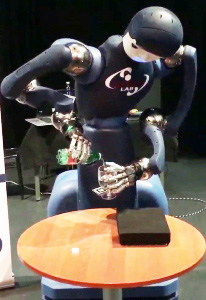 New generation of robots, to serve and substitute humans in various kinds of application, should have comparable abilities to deftly move, autonomously learn and make decisions. Analytical approaches to manipulation require precise model of the objects, accurate description of the task, and evaluation of object affordance, which all make the process time consuming. To learn and execute new tasks just as humans do, i.e. through trial-and-error and compliant adaptation to the environment, human-like physical interaction is crucial. Therefore, advanced mechanical designs such as tendon-driven actuation, underactuated compliant mechanisms and hyper-redundant/continuum robots might exhibit enhanced capabilities of adapting to changing environments. As a matter of fact, high degrees of freedom (DoF) and compliance increase the complexity of modelling and control of these devices. To this purpose, the adoption of coordinated motion patterns leads to a problem of reduced dimension. As a consequence, model-based control strategies of manipulation activities can be learned from human experience and, relying on dimensionality reduction, can be integrated with model-free reinforcement learning algorithms which have the potential to learn from actions.
New generation of robots, to serve and substitute humans in various kinds of application, should have comparable abilities to deftly move, autonomously learn and make decisions. Analytical approaches to manipulation require precise model of the objects, accurate description of the task, and evaluation of object affordance, which all make the process time consuming. To learn and execute new tasks just as humans do, i.e. through trial-and-error and compliant adaptation to the environment, human-like physical interaction is crucial. Therefore, advanced mechanical designs such as tendon-driven actuation, underactuated compliant mechanisms and hyper-redundant/continuum robots might exhibit enhanced capabilities of adapting to changing environments. As a matter of fact, high degrees of freedom (DoF) and compliance increase the complexity of modelling and control of these devices. To this purpose, the adoption of coordinated motion patterns leads to a problem of reduced dimension. As a consequence, model-based control strategies of manipulation activities can be learned from human experience and, relying on dimensionality reduction, can be integrated with model-free reinforcement learning algorithms which have the potential to learn from actions.
The purpose of the workshop is to portray the level of autonomy that anthropomorphic robotic systems have reached today and to chart possible paths towards improved manipulation capabilities by means of self-adaptability to the environment. The workshop intends to spotlight how autonomy depends on the ability to adapt to the environment by learning from experience, and how, for this purpose, physical interaction is critical and consequently smart design makes the difference. This workshop aims at discussing the integration of learning, control and design aspects that should not be separated in the complex problem of robotic manipulation. Indeed, these aspects can interact and take advantage of one another being inspired by the functioning, reasoning and physical resemblance of human beings. Of course, in this contest the perception is involved in the process and the integration of visual and tactile sensing is a crucial issue during the interaction with the environment.
Some of the questions we will try to answer are:
- How human experience can help to develop new paradigm for anthropomorphic devices control
- How a synergistic approach can help to simplify modeling of high degrees of freedom systems
- How dimensionality reduction will help the learning process
- How vision and tactile information can be integrated in the learning process and in control strategies
This workshop is supported by:

MUSHA (MUltifunctional Smart HAnds)

LEACON (LEArning-CONtrol tight interaction: a novel approach
to robust execution of mobile manipulation tasks) - Marie Skłodowska-Curie Individual Fellowship


